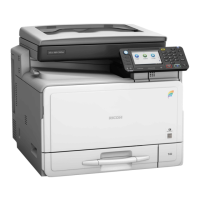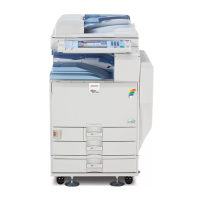Securing data when IPsec is unavailable
The following procedures make user data more secure when IPsec is unavailable.
Administrators must inform users to carry out these procedures.
Fax
• Sending and receiving faxes without using IP-Fax
When sending faxes, specify destinations by fax number, Internet Fax destination, e-mail
address, or folder destination. Do not specify destinations by IP-Fax destination. For details
about specifying the destination for a facsimile, see "Specifying a Destination", Fax.
Printer
•
Printing with protocols that support encryption
To use the printer functions, specify sftp as the protocol, or specify IPP and enable SSL/TLS.
For details about sftp, see "Printing Files Directly from Windows", Connecting the Machine/
System Settings.
For details about IPP settings, see "Installing the Printer Driver for the Selected Port", Driver
Installation Guide.
For details about SSL/TLS settings, see p.132 "Configuring SSL/TLS".
Scanner
• Sending the URL address of stored files
Send the URL of scanned files to destinations by configuring [Send Settings] in [Scanner
Features], instead of sending the actual scanned files. For details, see "Sending the URL by E-
mail", Scan.
• Managing scanned files using Web Image Monitor
Use Web Image Monitor through your network to view, delete, send, and download scanned
files.
• S/MIME authentication function
When sending scanned files attached to e-mail, protect them by applying an S/MIME
certificate. To do this, configure the "Security" settings prior to sending. For details about
sending e-mail from the scanner, see "Basic Procedure for Sending Scan Files by E-mail",
Scan.
• For details about enabling and disabling IPsec using the control panel, see "System Settings",
Connecting the Machine/ System Settings.
• For details about specifying the IPsec setting via Web Image Monitor, see p.145 "Configuring
IPsec".
Additional Information for Enhanced Security
275

